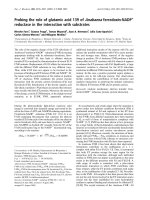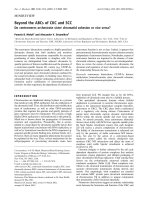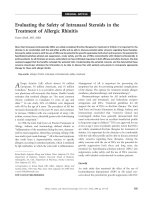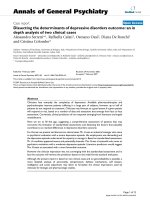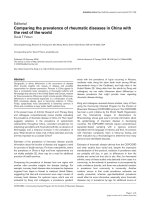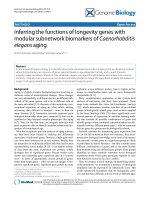Báo cáo y học: "Reappraising the concept of massive transfusion in trauma" doc
Bạn đang xem bản rút gọn của tài liệu. Xem và tải ngay bản đầy đủ của tài liệu tại đây (777.75 KB, 8 trang )
RESEARCH Open Access
Reappraising the concept of massive transfusion
in trauma
Simon J Stanworth
1*
, Timothy P Morris
2
, Christine Gaarder
3
, J Carel Goslings
4
, Marc Maegele
5
, Mitchell J Cohen
6
,
Thomas C König
7
, Ross A Davenport
7
, Jean-Francois Pittet
8
, Pär I Johansson
9
, Shubha Allard
10
, Tony Johnson
2,11
,
Karim Brohi
7
Abstract
Introduction: The massive-transfusion concept was introduced to recognize the dilutional complications resulting
from large volumes of packed red blood cells (PRBCs). Definitions of massive transfusion vary and lack supporting
clinical evidence. Damage-control resuscitation regimens of modern trauma care are targeted to the early
correction of acute traumatic coagulopathy. The aim of this study was to identify a clinically relevant definition of
trauma massive transfusion based on clinical outcomes. We also examined whether the concept was useful in that
early prediction of massive transfusion requirements could allow early activation of blood bank protocols.
Methods: Datasets on trauma admissions over a 1 or 2-year period were obtained from the trauma registries of
five large trauma research netw orks. A fractional polynomial was used to model the transfusion-associated
probability of death. A logistic regression model for the prediction of massive transfusion, defined as 10 or more
units of red cell transfusions, was developed.
Results: In total, 5,693 patient records were available for analysis. Mortality increased as transfusion requirements
increased, but the model indicated no threshold effect. Mortality was 9% in patients who received none to five
PRBC units, 22% in patients receiving six to ni ne PRBC units, and 42% in patients receiving 10 or more units. A
logistic model for prediction of massive transfusion was developed and validated at multiple sites but achieved
only moderate performance. The area under the receiver operating characteristic curve was 0.81, with specificity of
only 50% at a sensitivity of 90% for the prediction of 10 or more PRBC units. Performance varied widely at different
trauma centers, with specificity varying from 48% to 91%.
Conclusions: No threshold for definition exists at which a massive transfusion specifically results in worse
outcomes. Even with a large sample size across multiple trauma datasets, it was not possible to develop a
transportable and clinically useful prediction model based on available admission parameters. Massive transfusion
as a concept in trauma has limited utility, and emphasis should be placed on identifying patients with massive
hemorrhage and acute traumatic coagulopathy.
Introduction
Hemorrhage is res ponsible for more than 40% of all
trauma deaths and therefore represents an important
target for improving outcomes after severe injury. The
concept of massive transfusion has existed for more
than half a century and was developed to highlight the
dilutional complications occurring when administering
large volumes of packed red blood cells (PRBCs) or
other fluids, which could be addressed by the use o f
massive-transfusion protocols. Such protocols are not
immediately activated but typically require either the
presence of abnormal laboratory tests of coagulation
[1,2] or the prior administration of a certain number of
units of PRBCs [3].
It is now clear that standard massive-transfusion algo-
rithms are less effective in trauma hemorrhage [4,5]. Pri-
marily, this is due to the presence of an endogenous
coagulopathy very early in the clinical course of trauma
* Correspondence:
1
NHS Blood & Transplant, Oxford Radcliffe Hospitals Trust, John Radcliffe
Hospital, Headley Way, Headington, Oxford, OX3 9BQ, UK
Full list of author information is available at the end of the article
Stanworth et al. Critical Care 2010, 14:R239
/>© 2010 Maegele et al.; licensee BioMed Central Ltd. This is an open access article distributed under the terms of the Creative Commons
Attribution License ( which permits unrestricted use, distribution, and reproduction in
any medium, provided the original work is properly cite d.
patients, due to the presence of shock and tissue hypo-
perfusion [6]. This acute traumatic coagulopathy (ATC)
maybeestablishedbythetimethepatientarrivesinthe
emergency department [7-10] and is strongly associated
with the need for large volumes of blood transfusion [10].
New damage-control resuscitation protocols targeted at
ATC call for earlier plasma and blood-component regi-
mens [11], and significant improvements in outcome
may be achievable with such strategies [12-14].
In the absence of validate d near-patient diagnostic
tools for ATC, some centers are moving to empiric
transfusion protocols activated early on the basis of clin-
ical judgment [3]. Prediction models for massive transfu-
sion have been developed in both civilian [15-17] and
military [18-20] settings, although in general, these pub-
lished tools have only moderate performance. In clinical
use, where sensitivity rates of more than 90% would be
important, these tools have very low specificities of
around 50%. These models were developed in specific
populations and remain largely unvalidated outside of
their original datasets.
We designed this international multicenter study to
reappraise the utility of massive transfusion as a clinical
concept in modern trauma care. The first aim of the
study w as to assess whether a clinically relevant defini-
tion of massive transfusion existed in terms of a clinical
outcome. The second aim was to assess by predictive
modeling whether transfusion therapy can be rapidly
and appropriately instit uted by using paramete rs poten-
tially available on trauma center admission.
Materials and methods
Datasets on trauma admissions were obtained from the
trauma registries of a research network of major trauma
centers. Participating trauma centers were the Royal
London Hospital, London, UK; Oslo University Hospital
Ulleval, Norway; Academic Medical Centre, Amsterdam,
the Netherlands; and San Francisco General Hospital,
San Francisco, California, USA. Data from The Trauma
Registry of the Deutsche Gesellschaft für Unfallchirurgie
(TR-DGU) [21,22] from Germany, which covers more
than 100 hospitals, were also included. The datasets
included information over a 1-year perio d (2007) except
the Oslo dataset covering 2 years (from June 2005). The
data included patient age, sex, penetrating injury (yes/
no), time from injury to emergency department arrival,
admission systolic blood pressure, b ase deficit, pro-
thrombin time (PT) and Injury Severity Score (ISS) [23],
number of packed red blood cells (PRBCs) transfused in
the first 24 hours, and in-hospital or 30 day (Oslo) mor-
tality. The authors confirm that each trauma registry of
the network is approved by a local review board and is
in compliance with the institutional and/or national
legal frameworks and data-protection requirements.
Informed consent was not required, according to institu-
tional, local and national guidelines. All data collection
and analysis was performed anonymously.
A fractional polynomial was used to relate the odds of
death to PRBCs received by logistic regression; these
polynomials allow great flexib ility by combining combi-
nations of integer powers (such as squares and cubes)
and noninteger powers such as one-half (square root),
one third (cubic root), and others.
We then developed a lo gistic regression model for the
prediction of massive transfusion, defined as 10 or more
units of PRBCs. Missing data were a problem and were
dealt with by using multiple imputation by chained
equations [24,25] under the assumption of missing at
random [26]. Fifty imputed datasets were created (since
time to emergency department was unobserved in 42%
of patients) by using predictive mean matching, retain-
ing imputed values obtained after 100 cycles. The impu-
tation model was specified t o be at least as complex as
the prognostic model [27], including all candidate pre-
dictors. Normalizing transformations of the observed
continuous variables were taken so that the distributions
of imputed and observed values were similar. All candi-
date predictors potentially available on admission and
thought to be associated with transfusion were consid-
ered. Center-specific effects were excluded to allow gen-
eraliza bility of results. Model parameters were estimated
by combining across imputed datasets [28]. Backward
elimination was used to select variables, with P >0.1as
the elimination criterion. A shrinkage factor was applied
to log odds ratios after model fitting before validation
[29]. The same model was also fitted by using complete
data without any i mputation, to assess for any effects of
imputation. The results were consistent with the mult i-
ple-imputation analysis, alt hough the parameters were
estimated w ith greater precision with imputation (data
not shown). The Amsterdam data were not included in
this complete analysis without imputatio n, because time
to emergency department was not recorded at thi s
center.
Two training-validation dataset scenarios were used.
First, TR-DGU data from Germany were used for exter-
nal validation [30], with all other data used for training.
The German TR-DGU registry data contributed 1,705
patients, 30% of the total dataset, and was considered to
be of a suitable size for validation. Further, no data were
missing. As a second (internal) validation, da ta were
split randomly with 60% of patients from each center in
the training dataset and 40% in the validation dataset.
Calibration [31] and receiver operating characteristic
(ROC) plots were examined, along with sensitivity and
likelihood ratio, at 90% specificity. The calibration plot
was formed by predicting the likelihood of massive
transfusion for each patient in the validation dataset
Stanworth et al. Critical Care 2010, 14:R239
/>Page 2 of 8
[32]. Individuals were then grouped by predicted prob-
ability, and these groups were compared with the
observed transfusions rece ived. After validation, the
model was evaluated with the full dataset. We examined
between-center v ariation in the performance of the
model to investigate the effect of center-specific transfu-
sion practic es. For these purposes, the model including
variables chosen from the previous two analyses was
fitted, and the predictive value was tested in each center
separately to see h ow variable this was. All statistical
analyses and graphics were produced in Stata version
10.1 (StataCorp, 4905 Lakeway Drive, College Station,
TX, USA).
Results
In total, 5,693 patient records were available for analysis.
Patient demographics, injury characteristics, admission
physiology, base deficit, a nd prothrombin times are
shown in Table 1. Records of 2,497 (44%) patients had a
complete set of observed covariates, whereas one covari-
ate was missing in 1,788 (31%) and two (14%) in 850.
Mortality increased as transfusion requirements
increased (Figure 1). No threshold effect was seen at
10 units or any other val ue of PRBC tra nsfusions. Mor-
tality was 426 (9%) of 4,808 in patients who received
none to five PRBC units, 82 (22%) of 367 in patients
receiving six to nine PRBC units, and 217 (42%) of 518
in patients receiving 10 or more PRBC units. The frac-
tional polynomial model for transfusion-associated prob-
ability of death, adjusting for any institution effect, is
shown in Figure 2. The open dots above and below the
fitted line (deviance residuals) represent patients who
died (above) and survived (below). These serve to illus-
trate that transfusion for patients who died and survived
extends over the range of PRBC transfusions up to 30.
The model d id not demonstr ate any steps or plateaus:
each additional unit of blood transfused was associated
with an increased risk of death.
Table 2 reports the reg ression coefficients from the
logistic reg ression model. For the prediction of patients
requiring massive transfusion, transformation toward a
normal distribution for skewed continuous covariates
was undertaken, as shown in column 1, Table 2. Log-
odds and odds ratios for each variable are shown ( log-
odds can be m ore readily added together to calculate
Table 1 Demographics
Number
missing
All patients
(n = 5,693)
London
(n = 788)
Oslo
(n = 2167)
San Francisco
(n = 384)
Amsterdam
(n = 649)
TR-DGU
(n = 1705)
Massive transfusion
cases (%)
0 518 (9%) 69 (9%) 68 (3%) 47 (12%) 12 (2%) 322 (19%)
Age in years
(range)
24 (0.4%) 36 (24 to 53) 33 (24 to 46) 34 (21 to 51) 40 (26 to 56) 33 (20 to 49) 41 (27 to 58)
Male (%) 0 4,161 (73%) 636 (81%) 1,539 (71%) 294 (77%) 451 (69%) 1,241 (73%)
Penetrating
injury (%)
23 (0.4%) 580 (10%) 150 (26%) 177 (8%) 125 (22%) 29 (5%) 99 (17%)
Injury Severity
Score (range)
86 (2%) 17 (9 to 29) 16 (6 to 26) 12 (5 to 22) 18 (10 to 29) 5 (1 to 15) 27 (18 to 38)
Systolic blood
pressure,
mean (SD)
(mm Hg)
425 (7%) 126 (29) 127 (30) 130 (32) 130 (32) 138 (26) 116 (29)
Base deficit, mean
(mM, range)
865 (15%) 2.3 (0.2 to 5.3) 2.6 (0.4 to 6.2) 1.2 (-0.6 to 3.4) 5.5 (3.0 to 9.3) 1.3 (-0.4 to 3.2) 3.4 (1.1 to 6.2)
Prothrombin time
(seconds, range)
1,648 (29%) 14.1 (13 to 16.8) 12.0 (12.0 to 13.2) 13.2 (13.2 to 15.6) 14.4 (13.5 to 15.5) 14.1 (13.4 to 14.8) 15.8 (13.0 to 21.0)
Time to
emergency
department
(minutes, range)
2,396 (42%) 56 (37-80) 62 (49 to 81) 47 (30 to 85) 27 (22 to 35) – 63 (48 to 85)
The Amsterdam dataset did not record time from injury to emergency department arrival, and coagulation data in the German TR-DGU registry were recorded as
Quick values for prothrombin time [39]. The Oslo dataset covers a 2-year period. TR-DGU, Trauma Registry of the Deutsche Gesellschaft für Unfallchirurgie.
Figure 1 Transfusion-related mortality. Mortality by packed red
blood cells (PRBCs) administered during the first 24 hours of
admission.
Stanworth et al. Critical Care 2010, 14:R239
/>Page 3 of 8
patient-specific probability of massive transfusion, and
odds ratios are more meaningful for considering the
impact of an individual predictor). The variables with
the most weight in the model were systolic blood pres-
sure (Figure 3a), base deficit (Figure 3b) and prothrom-
bin time (Figure 3c). Age, penetrating injury, and time
to emergency department were also identified as impor-
tant dependent variables. Injur y severity is known to be
related to transfusion requirements (Figure 3d), but
because accurate ISS scores are not directly available on
admission, these measures were exclu ded from the final
model, as shown. However, when a model including ISS
was fitted, it was found that ISS was a significant predic-
tor and gave more accurate predictions of massive trans-
fusion (data not shown). For continuous variables, the
odds ratios apply to a unit increase in the transformed
variable (for example, √age). A patient’s logit probability,
A, of transfusion could be calculated by summing the
intercep t and approp riate log-odds ratios for their para-
meters by using Table 2. The probability of massive
transfusion was then calculated from
exp
exp
A
A
()
+
()
1
.
The receiver operating characteristic (ROC) curve is
showninFigure4aandhasanareaunderthecurve
(AUC) of 0 .81, externally validated on the German TR-
DGU data. Thi s model performed less well at intermedi-
ate and higher probabilities of 10+ PRBC transfusions
(Figure 4b). At a sensitivity of 90%, specificity for massive
transfusion was only 50%, with 58% of patients correctly
classified. For the internal validation (60 to 40 split), the
identical set of variables was selected; in this case, the
AUC was 0.89 (95% confidence interval, 0.87 to 0.92),
with a specificity of 70% at 90% sensitivity. The model
varied in performance when applied to specific trauma
centers. At a sensitivity of 90%, the specificity varied
from 48% (San Francisco) to 91% (Amsterdam). Com-
plete data analysis was entirely consistent with the multi-
ple imputation analys is in ter ms of parameter estimates
andconfidenceintervals(CIs).Theonlydifference
was reflected in less-precise parameter estimates,
as would be expected. Because validation was on the
German TR-DGU centers, and these had no missing
data, the inferences were very similar to those using mul-
tiple imputation.
Discussion
This international multicenter study was conducted to
evaluate the clinical applicability of massive transfusion
as a c oncept in modern trauma care. The five trauma
datasets represent a range of sizes and activities, which
are likely to be generalizeable to many different trauma
units worldwide. Any definition of massive transfusion
should be useful in terms of its relevance to patient out-
come. We have shown an association between transfu-
sion and mo rtality, with a co ntinuous increase in risk,
and with a steeper increase in the lower ranges of the
curve. We were not able to identify the traditional
10 units of PRBCs or any other specific threshold defini-
tion of massive transfusion, based on a mor tality
Figure 2 Estimated probability of death per unit of packed red
blood cells (PRBCs) administered (95% confidence interval in
grey). Dots are deviance residuals. The band of dots above the line
represents patients who died; the band below is those who
survived.
Table 2 Regression coefficients from logistic regression model
Log-odds ratio (SEM) Odds ratio (95% CI)
√age 0.16 (0.05) 1.2 (1.1 to 1.3)
Ln (time to emergency department) 0.06 (0.17) 1.1 (0.8 to 1.5)
Penetrating injury 0.4 (0.24) 1.5 (0.9 to 2.4)
Systolic blood pressure -0.02 (0.003) 0.98 (0.97 to 0.98)
ln(25
a
+ base deficit) 5.48 (0.5) 240 (91 to 639)
1/(ln(prothrombin time
2
)) -26.7 (4.3) 2.5 × 10
-12
(5.3 × 10
-16
to 1.2 × 10
-8
)
Intercept -16.7 (2.3) -
a
25 is an arbitrary constant added to base deficit to ensure positive values before logarithmic transformation.
Stanworth et al. Critical Care 2010, 14:R239
/>Page 4 of 8
outcome. Patients receiving six to nine units of PRBCs
had nearly 2.5 times the mortality of patients receiving
none to five units. Management strategies targeted at
patients receiving a threshold of 10 or more PRBC units
will exclude a large proportion of patients receiving
fewer transfusions but who still have a significant mor-
tality. Research studies examining only massively trans-
fused patients, according to this definition, will therefore
exclude an importa nt patient group. Moreover, thera-
peutic intervention studies will be confounded by any
treatment effect that results in reduc ed PRBC require-
ments and therefore the inappropriate exclusion of
patients from the study population. This may be one
factor relevant to discussions about the internal validity
of retrospective reports suggesting benefit with increased
plasma and platel et transfusions in massively transfused
patients [12-14,33-35].
The utility of the massive-transfusion concept m ay
better apply for its therapeutic potential, and it may
havearoleintheactivationofmajorhemorrhage
protocols. Damage-control resuscitation strategies
require early administration of blood-component ther-
apy along with the first units of PRBCs [11], and
attempts have been made to develop prediction algo-
rithms for massive transfusion [15-20]. Our prediction
model has been robustly validated across multiple cen-
ters, a larger sample size, and a wider geographic area,
and uses variables that are potentially available soon
after arrival in the emergency department. However, the
performance of the model w as only moderate, and the
AUC of our tool of 0.81 is consistent with other predic-
tion tools (0.68 to 0.85) [15-20]. Setting the sensitivity at
a clinically useful threshold of 90% (at which 10% of
actively bleeding patients wi ll be missed i nitially), the
tool has a specificity of only 50%. [15-20]. The conse-
quences of lower specificity is the risk of inappropriate
activations of transfusion protocols, wasting of blood
products, and increased exposure of patients to adverse
events related to transfusion. The po tentially harmful
effects of PRBCs in trauma patients, e specially in
Figure 3 Scatterplots showing admission parameters and injury severity associated with transfusion requirements. Where covariates are
missing for patient data, an average of imputed values has been substituted. (a) Packed red blood cells (PRBCs) transfusions by admission
systolic blood pressure. (b) PRBC transfusions by admission base deficit. (c) PRBC transfusions by admission prothrombin time. (d) PRBC
transfusions by injury-severity score.
Stanworth et al. Critical Care 2010, 14:R239
/>Page 5 of 8
relation to storage age, have been documented [36]. This
will have increasing impact as protocols move toward
much higher doses of plasma, platelets, fibrinogen, and
cryoprecipitate.
One of the reasons for the difficulties in developing
any models with high specificity and sensitivity is likely
to be the heterogeneity in patient populations of trauma.
Existing transfusion practices may also limit its utility in
clinical practice. This study shows that the reliable pre-
diction of massive transfusion from standard admission
physiology alone is difficult. The components of the pre-
diction model were heavily weighted toward systolic
blood pressure, base deficit, and the prothrombin time,
which are the main features driving the development of
ATC [6].
The performance of the tool might be improved if a
better near-patient measure of the severity of the coagu-
lopathywereavailable(forexample, functional tests of
coagulation such as thromboelastometry or thromboe-
lastography) [37,38]. Injury severity is also a strong
dependent variable for the prediction of ATC and mas-
sive transfusion [6-9], but is not immediately available.
Whether it is possible to develop an alternative but
comparable measure for ISS that is available soon after
admission remains unclear. Currentl y, no biomarkers of
tissue injury are available, but such a rapidly available
measure might also significantly improve prediction
algorithms for ATC, massive hemorrhage, and patient
care. Future work must l ook at these alternative
approaches to developing a clinically useful prediction
tool, because even across multiple datasets and with the
application of several validation techniques, this study
was not able to develop a reliable prediction tool.
Some limitations exist in this study. It is a retrospec-
tive review of registry data in which a variable propo r-
tion of records contained missing data, but this is
inevitable to a degree in analyses of multiple registries.
Multiple imputation assumes that missing data are ran-
dom, having accounted for observ ed covariates, but this
may not have been the case if variables that predict
missing data w ere not recorded. However, the model
performed well against the German TR-DGU data,
which were more plentiful, indicating geographic trans-
portability [30]. Entry criteria for the datasets were also
recognized to be different. The San Francisco dataset
included o nly patients with a higher-level t rauma team
activation, whereas the German TR-DGU included only
patients with an ISS of 9 or higher. It was not possible
to standardize the measurements of PT between the
centers, as different thromboplastins were used, each
with a different laboratory-specific M ean Normal Pro-
thrombin Time (MNPT) and International Specificity
Index (ISI), although in this study, the variat ions in
reference ranges and results for PT were small, and the
majority of result s were normal o r only marginally
increased [39].
The mortalit y model may also be confounded because,
as for patients dying within 24 hours, the rate of PRBC
transfusion m ay have been higher than indicated in the
data [40]. In addition, it is difficult to exclude an effect
due to censoring for death, as some patients may die
before sufficient time to receive blood. The rate of
bleeding is not availabl e from standard registry data but
has been identified as an important confounder in the
retrospective high-dose plasma studies [3]. Another lim-
itation is the lack of information between centers on
indications for transfusing PRBCs, the variation in trans-
fusion practices, an d the use of hemostatic drugs such
as antif ibrinolytics or even recombinant activated factor
Figure 4 Performance of the massive-transfusion prediction
tool. The performance of the model developed on non-German
TR-DGU centers and validated on German TR-DGU registry data (see
text). (a) Receiver operating characteristic plot. Area under the ROC
curve, 0.81. (b) Calibration plot.
Stanworth et al. Critical Care 2010, 14:R239
/>Page 6 of 8
VIIa [41]. Massive transfusion not only is the result of a
set of clinical parameters but it also is a function of the
clinical response to them.
Conclusions
In summary, current definitions of massive transfusion
are not supported by clinical outcomes and are not use-
ful for guiding management. Rather , mortality increases
with each PRBC unit required, although not linearly.
The robust prediction of massive transfusion from stan-
dard admission parameters remains difficult. The c on-
cept of massive hemorrhage may be more useful than is
massive transfusion for modern trauma care. New
approaches are required for the early diagnosis of
patients with acute traumatic coagulopathy who are
actively bleeding and will go on to require significant
blood-component transfusions.
Key messages
• Red cell requirements in tra uma correlate with
mortality.
• No clinically relevant threshold defines massive
transfusion in terms of clinical outcomes.
• Red cell tran sfusion requirements cannot reliably
be predicted on the basis of standard physiological
variables available on admission.
• Attention should be focused on identifying patients
with massive hemorrhage.
• New diagnostic modalities are needed for the early
identification of acute traumatic coagulopathy.
Abbreviations
ATC: acute traumatic coagulopathy; AUC: area under the curve; ISI:
international specificity index; ISS: injury severity score; MNPT: mean normal
prothrombin time; PRBC: packed red blood cell; PT: prothrombin time; ROC:
receiver operating characteristic; TR-DGU: Trauma Registry of the Deutsche
Gesellschaft für Unfallchirurgie.
Acknowledgements
The authors thank Teun Peter Saltzherr (Trauma Unit AMC Amsterdam, The
Netherlands), Nils Oddvar Skaga and Morten Hestnes (Trauma Registry, Oslo
University Hospital Ulleval, Norway), and Anita West (Royal London Hospital,
London, UK) for their assistance in collecting the data used in this study.
Furthermore, the authors acknowledge all centers and hospitals that are
actively contributing data into the TR-DGU and Rolf Lefering (IFOM, Cologne,
Germany) for data management. The authors confirm that no external
funding existed for the study.
Author details
1
NHS Blood & Transplant, Oxford Radcliffe Hospitals Trust, John Radcliffe
Hospital, Headley Way, Headington, Oxford, OX3 9BQ, UK.
2
Medical Research
Council (MRC), Clinical Trials Unit, 222 Euston Road, London, NW1 2DA, UK.
3
Department of Traumatology, Division of Critical Care, Oslo University
Hospital Ulleval, Kirkeveien 166, 0407 Oslo, Norway.
4
Trauma Unit,
Department of Surgery, Academic Medical Center, University of Amsterdam,
Meibergdreef 9, 1105 AZ Amsterdam, The Netherlands.
5
Department of
Traumatology and Orthopedic Surgery, Institute for Research in Operative
Medicine (IFOM), Cologne-Merheim Medical Center (CMMC), University of
Witten/Herdecke, Campus Cologne-Merheim, Ostmerheimerstr. 200, 51109
Cologne, Germany.
6
Department of Surgery, San Francisco General Hospital,
University of California San Francisco (CA), Campus Box 0807, San Francisco,
CA 94143-0807, USA.
7
Trauma Clinical Academic Unit, Barts and the London
School of Medicine & Dentistry, Queen Mary, University of London, Mile End
Road, London, E1 4NS, UK.
8
Departments of Anesthesiology and Surgery,
University of Alabama at Birmingham, 804 Jefferson Tower, 619 South 19th
Street, Birmingham, AL 35249-6810, USA.
9
Capital Region Blood Bank,
Rigshospitalet, University of Copenhagen, Blegdamsvej 9, 2100 Copenhagen,
Denmark.
10
NHS Blood & Transplant/Barts & London Trust, The Royal London
Hospital, Whitechapel Road, Whitechapel, London, E1 1BB, UK.
11
MRC
Biostatistics Unit, Institute of Public Health, University Forvie Site, Robinson
Way, Cambridge, CB2 0SR, UK.
Authors’ contributions
KB conceived the study, TM and TJ undertook the statistical analysis with SS
and KB, and all other authors contributed to study design, data sharing, and
writing of the manuscript.
Competing interests
The authors declare that they have no competing interests.
Received: 20 April 2010 Revised: 20 August 2010
Accepted: 30 December 2010 Published: 30 December 2010
References
1. College of American Pathologists: Practice parameters for the use of fresh
frozen plasma, cryoprecipitate and platelets. JAMA 1994, 271:777-781.
2. British Committee for Standards in Haematology, Stainsby D, MacLennan S,
Thomas D, Isaac J, Hamilton PJ: Guidelines on the management of
massive blood loss. Br J Haematol 2006, 135:634-641.
3. Geeraedts LM Jr, Demiral H, Schaap NP, Kamphuisen PW, Pompe JC,
Frölke JP: ’Blind’ transfusion of blood products in exsanguinating trauma
patients. Resuscitation 2007, 73:382-388.
4. Gonzalez EA, Moore FA, Holcomb JB, Miller CC, Kozar RA, Todd SR,
Cocanour CS, Balldin BC, McKinley BA: Fresh frozen plasma should be
given earlier to patients requiring massive transfusion. J Trauma 2007,
62:112-119.
5. Ho AM, Karmakar MK, Dion PW: Are we giving enough coagulation
factors during major trauma resuscitation? Am J Surg 2005, 190:479-484.
6. Brohi K, Cohen MJ, Davenport RA: Acute coagulopathy of trauma:
mechanism, identification and effect. Curr Opin Crit Care 2007, 13:680-685.
7. Brohi K, Singh J, Heron M, Coats T: Acute traumatic coagulopathy. J
Trauma 2003, 54:1127-1130.
8. MacLeod JB, Lynn M, McKenney MG, Cohn SM, Murtha M: Early
coagulopathy predicts mortality in trauma. J Trauma 2003, 55:39-44.
9. Maegele M, Lefering R, Yucel N, Tjardes T, Rixen D, Paffrath T, Simanski C,
Neugebauer E, Bouillon B, AG Polytrauma of the German Trauma Society
(DGU): Early coagulopathy in multiple injury: an analysis from the
German Trauma Registry on 8.724 patients. Injury 2007, 38:298-304.
10. Brohi K, Cohen MJ, Ganter MT, Matthay MA, Mackersie RC, Pittet JF: Acute
traumatic coagulopathy initiated by hypoperfusion: modulated through
the protein C pathway? Ann Surg 2007, 245 :812-818.
11. Holcomb JB, Jenkins D, Rhee P, Johannigman J, Mahoney P, Mehta S,
Cox ED, Gehrke MJ, Beilman GJ, Schreiber M, Flaherty SF, Grathwohl KW,
Spinella PC, Perkins JG, Beekley AC, McMullin NR, Park MS, Gonzalez EA,
Wade CE, Dubick MA, Schwab CW, Moore FA, Champion HR, Hoyt DB,
Hess JR: Damage control resuscitation: directly addressing the early
coagulopathy of trauma. J Trauma 2007, 62:307-310.
12. Borgman MA, Spinella PC, Perkins JG, Grathwohl KW, Repine T, Beekley AC,
Sebesta J, Jenkins D, Wade CE, Holcomb JB: The ratio of blood products
transfused affects mortality in patients receiving massive transfusions at
a combat support hospital. J Trauma 2007, 63:805-813.
13. Zink KA, Sambasivan CN, Holcomb JB, Chisholm G, Schreiber MA: A high
ratio of plasma and platelets to packed red blood cells in the first 6
hours of massive transfusion improves outcomes in a large multicentre
study. Am J Surg 2009, 197:565-570.
14. Duchesne JC, Islam TM, Stuke L, Timmer JR, Barbeau JM, Marr AB, Hunt JP,
Dellavolpe
JD, Wahl G, Greiffenstein P, Steeb GE, McGinness C, Baker CC,
McSwain NE Jr: Hemostatic resuscitation during surgery improves
survival in patients with traumatic-induced coagulopathy. J Trauma 2009,
67:33-37.
15. Yücel N, Lefering R, Maegele M, Vorweg M, Tjardes T, Ruchholtz S,
Neugebauer EA, Wappler F, Bouillon B, Rixen D, Polytrauma Study Group of
Stanworth et al. Critical Care 2010, 14:R239
/>Page 7 of 8
the German Trauma Society: Trauma Associated Severe Hemorrhage
(TASH)-Score: probability of mass transfusion as surrogate for life
threatening hemorrhage after multiple trauma. J Trauma 2006,
60:1228-1236.
16. Nunez TC, Voskresensky IV, Dossett LA, Shinall R, Dutton WD, Cotton BA:
Early prediction of massive transfusion in trauma: simple as ABC
(assessment of blood consumption)? J Trauma 2009, 66:346-352.
17. Kuhne CA, Zettl RP, Fischbacher M, Lefering R, Ruchholtz S: Emergency
Transfusion Score (ETS): a useful instrument for prediction of blood
transfusion requirement in severely injured patients. World J Surg 2008,
32:1183-1188.
18. McLaughlin DF, Niles SE, Salinas J, Perkins JG, Cox ED, Wade CE,
Holcomb JB: A predictive model for massive transfusion in combat
casualty patients. J Trauma 2008, 64(2 suppl):S57-S63.
19. Schreiber MA, Perkins J, Kiraly L, Underwood S, Wade C, Holcomb JB: Early
predictors of massive transfusion in combat casualties. J Am Coll Surg
2007, 205:541-545.
20. Cancio LC, Wade CE, West SA, Holcomb JB: Prediction of mortality and of
the need for massive transfusion in casualties arriving at combat
support hospitals in Iraq. J Trauma 2008, 64(2 suppl):S51-S55.
21. Ruchholtz S, Lefering R, Paffrath T, Oestern HJ, Neugebauer E, Nast-Kolb D,
Pape HC, Bouillon B: Reduction in mortality of severely injured patients
in Germany. Dtsch Arztebl Int 2008, 105:225-231.
22. Maegele M, Lefering R, Paffrath T, Simanski C, Wutzler S, Bouillon B, Working
Group on Polytrauma of the German Trauma Society (DGU): Changes in
transfusion practice in multiply injury between 1993 and 2006: a
retrospective analysis on 5.389 patients from the German Trauma
Registry. Transfus Med 2009, 19:117-124.
23. Baker SP, O’Neill B, Haddon W Jr, Long WB: The injury severity score: a
method for describing patients with multiple injuries and evaluating
emergency care. J Trauma 1974, 14:187-196.
24. Van Buuren S, Boshuizen HC, Knook DL: Multiple imputation of missing
blood pressure covariates in survival analysis. Stat Med 1999, 18:681-694.
25. Royston P: Multiple imputation of missing values: further update of ice,
with an emphasis on interval censoring. Stata J 2007, 7:445-464.
26. Rubin DB: Inference and missing data. Biometrika 1976, 63:581-592.
27. Allison PD: Multiple imputation for missing data: a cautionary tale. Sociol
Methods Res 2000, 28:301-309.
28. Rubin DB: Multiple Imputation for Non-response in Surveys New York: John
Wiley; 1987.
29. Copas JB:
Regression, prediction and shrinkage. J R Stat Soc Series B
Methodol 1983, 45:311-354.
30. König IR, Malley JD, Weimar C, Diener HC, Ziegler A, German Stroke Study
Collaboration: Practical experiences on the necessity of external
validation. Stat Med 2007, 26:5499-5511.
31. Altman DG, Vergouwe Y, Royston P, Moons KG: Prognosis and prognostic
research: validating a prognostic model. BMJ 2009, 338:b605.
32. Altman DG, Royston P: What do we mean by validating a prognostic
model? Stat Med 2000, 19:453-473.
33. Scalea TM, Bochicchio KM, Lumpkins K, Hess JR, Dutton R, Pyle A,
Bochicchio GV: Early aggressive use of fresh frozen plasma does not
improve outcome in critically injured trauma patients. Ann Surg 2008,
248:578-584.
34. Kashuk JL, Moore EE, Johnson JL, Haenel J, Wilson M, Moore JB,
Cothren CC, Biffl WL, Banerjee A, Sauaia A: Postinjury life threatening
coagulopathy: is 1:1 fresh frozen plasma: packed red blood cells the
answer? J Trauma 2008, 65:261-270.
35. Snyder CW, Weinberg JA, McGwin GSM Jr, George RL, Reiff DA, Cross JM,
Hubbard-Brown J, Rue LW, Kerby JD: The relationship of blood product
ratio to mortality: survival benefit or survival bias? J Trauma 2009,
66:358-362.
36. Spinella PC, Carroll CL, Staff I, Gross R, Mc Quay J, Keibel L, Wade CE,
Holcomb JB: Duration of red blood cell storage is associated with
increased incidence of deep vein thrombosis and in hospital mortality
in patients with traumatic injuries. Crit Care 2009, 13:R151.
37. Rugeri L, Levrat A, David JS, Delecroix E, Floccard B, Gros A, Allaouchiche B,
Negrier C: Diagnosis of early coagulation abnormalities in trauma
patients by rotation thrombelastography. J Thromb Haemost 2007,
5:289-295.
38. Levrat A, Gros A, Rugeri L, Inaba K, Floccard B, Negrier C, David JS:
Evaluation of rotation thrombelastography for the diagnosis of
hyperfibrinolysis in trauma patients. Br J Anaesth 2008, 100:792-797.
39. Horsti J: Has the Quick or the Owren prothrombin time method the
advantage in harmonization for the international normalized ratio
system? Blood Coagul Fibrinolysis 2002, 13:641-646.
40. Hardy JF, de Moerloose P, Samana CM: The coagulopathy of massive
transfusion. Vox Sang 2005, 89:123-127.
41. CRASH-2 trial collaborators, Shakur H, Roberts I, Bautista R, Caballero J,
Coats T, Dewan Y, El-Sayed H, Gogichaishvili T, Gupta S, Herrera J, Hunt B,
Iribhogbe P, Izurieta M, Khamis H, Komolafe E, Marrero MA, Mejía-Mantilla J,
Miranda J, Morales C, Olaomi O, Olldashi F, Perel P, Peto R, Ramana PV,
Ravi RR, Yutthakasemsunt S: Effects of tranexamic acid on death, vascular
occlusive events, and blood transfusion in trauma patients with
significant haemorrhage (CRASH-2): a randomised, placebo-controlled
trial. Lancet 2010, 376:23-32.
doi:10.1186/cc9394
Cite this article as: Stanworth et al.: Reappraising the concept of
massive transfusion in trauma. Critical Care 2010 14:R239.
Submit your next manuscript to BioMed Central
and take full advantage of:
• Convenient online submission
• Thorough peer review
• No space constraints or color figure charges
• Immediate publication on acceptance
• Inclusion in PubMed, CAS, Scopus and Google Scholar
• Research which is freely available for redistribution
Submit your manuscript at
www.biomedcentral.com/submit
Stanworth et al. Critical Care 2010, 14:R239
/>Page 8 of 8


